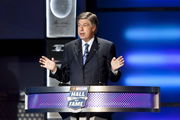
USA Today via Reuters
Aug 26, 2023; Daytona Beach, Florida, USA; NASCAR Cup Series drivers race during the Coke Zero Sugar 400 at Daytona International Speedway. Mandatory Credit: Mike Watters-USA TODAY Sports

USA Today via Reuters
Aug 26, 2023; Daytona Beach, Florida, USA; NASCAR Cup Series drivers race during the Coke Zero Sugar 400 at Daytona International Speedway. Mandatory Credit: Mike Watters-USA TODAY Sports
Racing is a game of inches and seconds. When the stakes are at an all-time high, every second matters as it even a tenth of a second can be a decisive factor in deciding the winner. Track position, lap times, and drivers’ capabilities all come into play when one is racing with the elite at the top of their game.
NASCAR is not different in that aspect as well. Compared to its competitors like Formula 1, NASCAR is a whole lot more unpredictable with the field ready to change its face at any moment of the race. Known for its aggressive style of racing, the organization has a lot riding on them. From capturing the community’s attention with its exhilarating products/events to ensuring the well-being and safety of its drivers, the sanctioning body has the humongous responsibility at hand to distinguish drama, and entertainment from outright aggression.
In fact, the organization has to strike the right chord when it comes to keeping its fanbase engaged by highlighting the raw nature of the sport while ensuring things don’t get out of hand with a balancing act. Though the sport has witnessed its share of vicious crashes in the past, in recent years, the organization has found its niche through constant efforts and years of innovation.
ADVERTISEMENT
Article continues below this ad
Yes, we’re talking about NASCAR’s Next-Gen platform that has taken the sport to greater heights. Despite the persistent backlash from fans and some drivers, the organization’s move to introduce these new-generation cars has hit the mark as they have struck the right chord with this one in terms of structural rigidity, safety, and affordability.
NASCAR and its path-breaking Next-Gen innovation
Across its 75 years, the Stock cars that have sped down the oval tracks have changed a lot compared to the early days of bootleg racing. From the old and stiff Buick and Hudsons that raced the local dirt ovals, the organization has certainly come a long way. When we look at the new and improved Next-Gen platform that is currently in use, one cannot ignore the significant differences.
Leave out the ’60s cars, and compare the Chase cars to the ones currently in use and the difference is pretty evident. Besides the drastically different body type, the state-of-the-art aerodynamic package, and the improved chassis, the Next-Gen platform is NASCAR’s leap of faith when it comes to innovation and sophistication – a move that the organization played close to the heart.

USA Today via Reuters
Aug 20, 2023; Watkins Glen, New York, USA; NASCAR Cup Series driver Austin Cindric (2) leads a group of cars during the Go Bowling at The Glen at Watkins Glen International. Mandatory Credit: Rich Barnes-USA TODAY Sports
While the basic idea of the new generation cars came in 2019 it took 3 years for everything to come to fruition as several factors including the pandemic held back the organization’s ambition. In 2022, the Next-Gen racecar’s inaugural season went underway. Amidst the dropping ratings and dwindling viewership, NASCAR’s efforts to level the playing field with more fair and equal equipment meant anyone could take the throne, making the sport more competitive than ever.
WATCH THIS STORY: Ford’s strategy save the day at Talladega Superspeedway
Joey Logano of Team Penske took the 2022 title as the #22 Ford trumped the consistent Toyotas and the fast Chevrolets, beating them to the punch. To sum up NASCAR’s vision concisely, the organization made a more competitive package without compromising the safety of its drivers by leveling the playing field with a masterstroke.
Trending
How different is a Next-Gen car compared to its predecessor?
Well, the short answer is, it’s quite different. The Chevy Camaro ZL1, the Ford Mustang and Toyota’s TRD Camry all have become more sleeker with the roof sliding down to give a more Coupe-like look. Another major change in the Next-Gen cars is the body fenders that have become fully symmetrical, making the new-gen cars more aerodynamic, reducing the drag coefficient considerably.
With this, the focus has now fallen back to the driver’s capabilities and teams’ setup, sort of evening the odds. Unlike sheet metal which was molded to fit the body panels, Next-Gen cars have composite material which on impact with walls or cars doesn’t compromise on performance. Thus making the cars more durable and reliable to take on the challenges of the field.
The lug nuts also have seen significant change, instead of the 5 nut assembly in the older cars, the new model has a 1 single lug nut setup, making tire changes super easy. Now, coming to the mechanical bits of the car, in order for the driver to feel at home in various tracks, the Next-Gen platform features an independent suspension, giving drivers more traction and rear-end feedback like never before.
Like most modern performance cars, they also come with rack and pinion steering configuration. The sequential transmission now has become more adaptable to feature electrical components that can send real-time data from the car, offering fans a new experience. The 7th generation car also comes with considerable chassis and aero changes. While the rear spoilers have become 1.5 inches shorter (from 4 to 2.5), the addition of advanced diffusers under the car and hood louvers has made the car more manageable in traffic with drivers effectively countering the dirty air.
To say the least, NASCAR through its systematic innovation has made the racecars more durable, competitive, and robust without compromising safety.
NASCAR’s Masterstroke and its Performance & Monetary Benefits
Since its founding in the late 40s, the National Association of Stock Car Auto Racing, or NASCAR as it is popularly known has seen several changes over the course of time. While the organization and its methodology have changed quite a bit, it is not the bootlegger racing series it was once. Rather, NASCAR is now a million-dollar series with 3 major divisions with several larger-than-life personalities and teams keeping thousands if not millions of fans across the world engaged with its aggressive style of racing.
To attract new investors, NASCAR’s steps towards making the racing series more affordable have become spot-on with the introduction of the Next-Gen cars. Instead of manufacturing parts and pieces themselves, NASCAR teams will now purchase parts for the Next Gen car from single sources such as Five Star Race Car Bodies, Dallara, McLaren, and others, streamlining the process in a big way.
Not just that with the organization implementing such changes, race cars have now become all the more affordable to smaller teams, prompting more players into NASCAR’s silly season draw. Race teams will now be regulated to have 7 cars per team(car number), also teams will not be allowed to replace a car until it’s used in at least 3 races.
Now, coming to the performance numbers, the cars will have a maximum power of 670 horsepower depending on the nature of the track. With the 7th gen cars becoming more robust, they can now take on the superspeedway in Talladega, the tight technical road course in COTA, to even the shortest track in the sport. Moreover, the modular design of the car chassis means, easy-to-work equipment for teams and a safer car for the drivers.
However, controversy hasn’t eluded the new racecars. Since its crash testing in early 2019, rumors have spread in the community that the Next-Gen cars are stiffer than their older counterparts with drivers receiving the blunt force of impact to their heads. But fortunately, that’s not entirely true. In fact, the cars have become considerably safer despite the horrific crashes NASCAR nation witnessed in recent months.
ADVERTISEMENT
Article continues below this ad
From vicious head-on collisions with the wall to the very recent Ryan Preece’s 10-flip wreck in Daytona all drivers have come out unscathed with minor injuries, the Next-Gen cars have truly stood all tests to have NASCAR’s head up high.
ADVERTISEMENT
Article continues below this ad
To sum up the things, these sophisticated Next-Gen cars are similar compared to their Supercar Racing counterparts in Oceania with similar structure, encouraging more drivers from around the world to compete.
The next is the exceptional safety system in these cars – cocooned inside the roll cage, the superior and durable chassis, and their modular design effectively absorbs the force of the impact rather than sending it to the driver as a whole. So, with the introduction of Next-Gen cars, NASCAR has made major strides in terms of safe, economical development of its already tried and tested race package with the adaptability of going around a mix of tracks. With all these improvements, we have to admit that these Next-Gen cars, although disliked by most, are a big step up in terms of technology and innovation.
ADVERTISEMENT
ADVERTISEMENT
ADVERTISEMENT
ADVERTISEMENT







